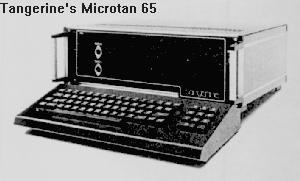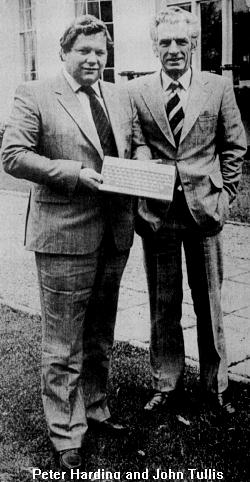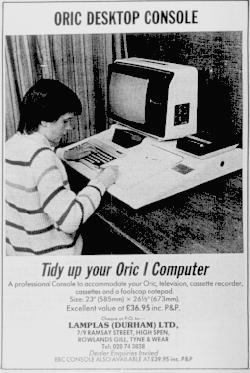Chapter 1
Conception and Birth


 While the Oric name was
born with such brave hopes, we have to go back in time for a moment to chronicle
the conception. It was in October 1979 that Dr. Paul Johnson and Barry Muncaster
set up Tangerine Computer Systems Ltd near Cambridge, and produced the Microtan
65 computer. The name followed the contemporary trend of fruity computer
companies.
While the Oric name was
born with such brave hopes, we have to go back in time for a moment to chronicle
the conception. It was in October 1979 that Dr. Paul Johnson and Barry Muncaster
set up Tangerine Computer Systems Ltd near Cambridge, and produced the Microtan
65 computer. The name followed the contemporary trend of fruity computer
companies.
In the summer of 1981 Paul Kaufman joined Tangerine, and became editor of the Tansoft Gazette on its launch that October. By early 1982 Tangerine had sold off their Tandata Prestel arm, moved to the Cambridge Science Park, and set up Tansoft as its software division.
 It was from those early
beginnings that the idea of a competitor in the infant home computer market
grew. In April 1982 Oric Products International Ltd was incorporated, and work
started immediately on the design of the Oric-1, Tangerine acting as the
research and development house for the new Oric company. The original aim had
been to produce an executive desktop machine which would link to Prestel and
compute. Paul Kaufman wrote a memo listing what he thought were the right
features for a Microtan 2 - sound and graphics, a modulator and so forth. The
result was a design in late 1981 for the Tangerine Tiger, a desktop machine with
three processors - a Z80 for CP/M, a 6809 for I/O, disc and printing, and a
graphics chip. In the end this design was sold off to a company called H.H.
Electronics, and never was produced. The Microtan 2 plus a Prestel capability
was the basis for the Oric.
It was from those early
beginnings that the idea of a competitor in the infant home computer market
grew. In April 1982 Oric Products International Ltd was incorporated, and work
started immediately on the design of the Oric-1, Tangerine acting as the
research and development house for the new Oric company. The original aim had
been to produce an executive desktop machine which would link to Prestel and
compute. Paul Kaufman wrote a memo listing what he thought were the right
features for a Microtan 2 - sound and graphics, a modulator and so forth. The
result was a design in late 1981 for the Tangerine Tiger, a desktop machine with
three processors - a Z80 for CP/M, a 6809 for I/O, disc and printing, and a
graphics chip. In the end this design was sold off to a company called H.H.
Electronics, and never was produced. The Microtan 2 plus a Prestel capability
was the basis for the Oric.
At this stage they saw what Sinclair had done, and financial backers British Car Auctions wanted higher volumes from the mass market to be the target. Thus was the Oric-1 born, although the first mock-up retained its executive image with a teak and apple-green colour scheme!
The Oric-1 was announced in the August/September 1982 edition of the Tansoft Gazette, which included a priority voucher valid until the 1st November.
Oric International was launched with Ј1250 of capital (probably the only time it was in the black). The name, incidentally, was an anagram of the last four letters of 'micro', and had nothing to do with Aurac, the computer in the contemporary television series 'Blake's Seven'.
 The shareholding was split
five ways between the directors, who were:
The shareholding was split
five ways between the directors, who were:
Managing director - John
Tullis
Sales director - Peter Harding
BCA financial director - Ted
Plumridge
Tangerine directors - Paul Johnson and Barry Muncaster
The backer was British Car Auctions, thanks to the friendship between John Tullis and BCA managing director and chairman David Wickens. Tangerine ceased trading and Tansoft was formed with Paul Kaufman as Managing Director. A 16k Oric would have cost you Ј129, a 48k Ј169.95. A modem price of Ј79.95 was also announced that January.
First into print with a review of the new machine was Popular Computing Weekly on the 13th January, 1983. Headlined (appropriately for those times) "Oric-1 - not just a Tangerine dream", it was billed as the first colour micro to cost less than Ј100. That was the 16k version, of course. The Centronics printer port was "unusual, even unique, for a machine at this price". The early temporary manual was criticised, as was the lack of a program editor in the review machine. But generally the review was very favourable. A quote which portended the future was there:
"Oric Products devote a lot of space in their advertisements to highlighting the advantages of the machine for the business user. They emphasise the availability of their modem, and promise (no date mentioned, however) microdrive discs and a speed printer."Every Oric-1 box contained a copy of Oric Owner issue 1, Jan/Feb 1983, published by Tansoft as the successor to the Tansoft Gazette. They were now based back in Ely at 3 Club Mews. The first Tansoft software was announced - Zodiac (converted from the Microtan version), Oric Chess, and OricBase. And there was a prediction for the future from Paul Kaufman, still the editor, which in hindsight makes interesting reading:
"An extended Basic, which gives the equivalent of B.B.C. basic, is almost ready to go into production."At the launch party Peter Harding had also promised a Pascal language by February. The intriguing question of what happened to these particular projects hasn't yet been answered.
And from Dr. Paul Johnson, the designer of the Oric:
"The next peripheral you will see for the Oric is the Modem, followed very quickly by 5.25" discs."Durrell advertised Lunar Lander for Ј5.00, an indication of just how difficult independent software houses were finding it to produce anything but the most basic software.
In Personal Computer News for the 10th February, 1983 there appeared a lengthy interview with Dr. Paul Johnson. Asked how the project began, he said:
"The Oric was first conceived by John Tullis back in the spring of last year. He had been employed as a financial consultant at Tangerine. While he was with us he came up with the idea for a home micro... We realised that we would have to develop a machine at the very low-cost end of the market. We stuck with the 6502 processor - which we use on the Microtan - because it's probably the world's best-selling chip... The most exciting thing for me about the Oric is its serial attributes capability. It will be invaluable in fast games to save memory... As a starting point, I knew that we wanted a viewdata compatible display. We did the TTL version back in the summer. Once that is working you know the logic is OK. Then I went to the U.S. to California Devices Inc, who were going to do the CMOS arrays. We first laid the ULA out as a plan to see where the problems would be. We had the first Oric working in August last year, using TTL emulators instead of the finished gate arrays. When the first finished chips came through from California in early December we took out the emulator, plugged in the chip and it worked first time. It was quite a relief!"And the quote of the interview:
"As well as being a great games machine, a lot of businessmen will buy the Oric to learn about computing. Some of them will go on to invest maybe Ј20,000 in a larger system but, for the corner sweet shop the Oric is all that's needed."As the first brochure put it, 'The Oric-1 should be on the desk of every informed executive'! I suppose hindsight is a wonderful thing.
The ROM was written mostly by two professional programmers, Andy Brown and Chris Shaw. Peter Halford ('Ratters'), who had worked at a Northampton TV shop, wrote the cassette routines - justifiably described as shoddy - and Oric Mon, which Geoff Phillips had to spend weeks debugging. Paul Kaufman wrote the sound routines on a Microtan in Forth, hand-coded them in machine code, and passed them to Andy Brown, who put them in the ROM.
 Paul Kaufman tells a nice
story of the moment when the ROM was first running successfully. The
machine-code programmers called for someone to enter a Basic program, and Paul
stepped forward. Thus was written the first ever Oric program:
Paul Kaufman tells a nice
story of the moment when the ROM was first running successfully. The
machine-code programmers called for someone to enter a Basic program, and Paul
stepped forward. Thus was written the first ever Oric program:
10 PRINT "Louise has lovely thighs"Louise was Barry Muncaster's secretary!
The plastic case was designed by outside professionals. Apparently there were arguments about the mock speaker holes. It was intended to have holes, but the plastic moulding machine could not cope and dummies were the compromise. The launch advertising and publicity designs were done by Paul Sample, who did the illustrations for Tom Sharpe's books.
That 10th February issue of P.C.N. also had the first advert for a peripheral - an Oric-1 cassette lead with motor control for Ј2.50 from Clares of Winsford, Cheshire.
Perhaps the most sensible conclusion was reached in the What Micro? review of February,1983:
"The Oric is sound, simple to get along with and offers great expansion potential. It's not an earth shattering novelty, but is very good value indeed."The first type-in appeared in Home Computing Weekly on the 8th March, 1983 - Junior Mathematician by one David Nowotnik. The next peripheral to market was the Oric Desktop Console, advertised in May, 1983 by a Durham firm. It was a two feet square slab of white plastic with a hole for the Oric, and cost Ј36.95. It was, in fact, well reviewed in the T.U.G. newsletter.
Back to the What Micro? review. It was generally favourable, but noted that the original UHF modulator had caused problems and a new one was being fitted on the latest machines. We also learn that Barry Muncaster had just become Managing Director of Oric, replacing John Tullis who became Chairman. The circuit boards were being made in Singapore using many American components, with only the plastic case being manufactured in the U.K. But the non-quote of the article was from Barry Muncaster:
"The faults in the Basic language have been tracked down and corrected. A new ROM has been ordered and should be in all machines leaving the factory after the start of April."Surely he didn't mean 1984? And again,
"Several add-ons will be available for people who pay Ј15 for an expansion box which will plug into the back of the Oric. The box is about the same size as the Oric and is strong enough to take the weight of a monitor sitting on top of it. There will be four slots inside the box to take various expansion modules and it will also take plug-in ROMs for things like alternative languages. It will have sockets to take standard joysticks. The first expansion module expected by May is a modem, the second by June a disc drive controller... The third module planned for the expansion box is a 'fun box'. It will contain A/D and D/A converters, a number of relays and anything else we can think of. It should appeal to the hobbyist. Various ideas are being considered for the fourth slot in the box, including a speech synthesiser... Oric will sell a 10" colour monitor for about Ј240."Oh well....